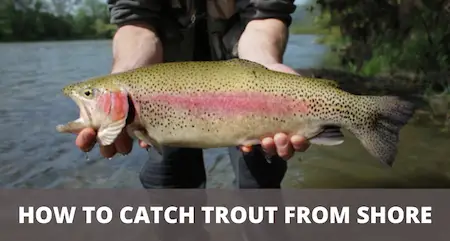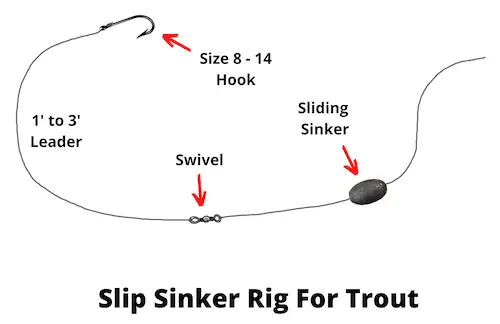How To Catch Trout From Shore (Detailed Guide)
UPDATED 03 NOVEMBER 2023
by Robert Ceran
Trout are among the most popular game fish in North America, and both novice and experienced anglers love to chase them.
In addition to the many lakes and rivers with natural trout populations, thousands of ponds are stocked with trout every year.
As a result, it’s very likely that you can find good trout fishing opportunities close to where you live.
The most common method for catching trout in lakes and ponds is shore fishing. But if you want to succeed with bank fishing for trout, it’s important to know the best practices for this kind of fishing.

In this article we’ll walk you through the details of trout fishing from shore – the best locations, setups, baits, and tips for catching trout from the shore.
What locations are best for catching trout from shore?
When choosing a good spot for trout fishing from shore, look for the following key characteristics. The most productive fishing spots are often found around prominent structural elements of the lake topography.
For example, these could be land points that protrude out into a lake. Another example is the drop off zone between a shallow bay and deeper water.
Most of the best trout fishing locations on lakes have in common that shallower parts of the lake are found juxtaposed to deeper water areas.
Since trout are coldwater fish, they generally like to hold in deeper water during the warm part of the year, but most of their food is found in more shallow zones.
So in summer you’ll often find them cruising around the lake in deeper water of 20 to 30 feet or more, but regularly making incursions into more shallow zones of 10 to 15 feet, where they feed on small fish, worms, and insect larvae.
If you can get a good lake map to study the underwater topography, that will be very helpful to find the most promising spots. In addition to the structural elements mentioned above, also try to look for cover, which includes submerged trees, brush piles, and wee beds.
Since it’s difficult to know in advance how deep to fish for trout from shore, the best fishing locations have access to a range of water depths, so you can test them out systematically until you determine the depth that trout are holding at.
Spring vs summer trout fishing from shore
Trout behavior changes over the course of every year, as they respond to changes in water temperature, oxygen levels, and movements of their favorite forage.
During spring time they start to emerge from deeper water where they held during the colder months, and can often be found actively feeding on insect larvae and other aquatic invertebrates between 10 and 15 feet of water.
Usually it’s easy to reach these feeding zones by casting from shore.
As the water temperature rises steadily during the summer months, trout retreat to deeper water of 15 feet or more, since they prefer the cooler temperatures found at these depths.
If you’re fishing from shore, it’s best if you can identify these locations with the help of a lake map, and cast your rig far enough from shore to reach the right depths.
As the water cools once more during the fall, trout can again be found feeding in more shallow water, similar to where you found them in spring.
Rod and reel setup for trout fishing from shore
The best trout fishing rod and reel setup for fishing from shore is a lightweight spinning setup with the following range of specs:
- Rod: fast action, light or ultralight power, 7’ to 8’ spinning rod
- Reel: 1000 to 2000 size spinning reel
- Main line: 6 to 8 lb test monofilament or braided line
- Leader: 4 to 6 lb test fluorocarbon (18” to 36” long)
You can use this setup for all the trout rigs described below, as well as for casting small trout lures with an ultralight trout rod.
Now let’s look at the different rigging options for trout shore fishing in more detail.
The best trout rigs for shore fishing
The best rigs for trout fishing from shore are the slip sinker rig and the slip bobber rig, but a fixed bobber rig can also be very effective when trout are feeding high in the water column.
Slip sinker rig

By far the best rig for trout fishing from shore is the slip sinker rig.
The reason for this is that it has enough weight to be cast quite far with a light spinning rod and reel setup, so you can cover a wide range of locations by casting from shore.
The best sliding sinker to use is either a 1/8 to 1/4 oz egg or bullet sinker. Thread your main line through the sinker, and then tie it to a barrel swivel.
Then tie the other end of the barrel swivel to a 1 to 2 foot long fluorocarbon leader that’s 2 lb test weaker than your main line. Then tie on a size 8 single hook, and you’re good to go.
The best way to use this rig is with floating bait (more on that below), since this will allow you to present your bait between 1 and 2 feet off the bottom, which is often an ideal depth to target trout.
Fixed bobber rig
If you find that trout are feeding higher in the water column, the slip sinker rig is not the best choice, as the trout won’t notice your bait below them.
In that case a bobber setup is a better choice, since you can adjust the depth of the baited hook by adjusting the position of your bobber along the line, and thus present your bait higher in the water column.
The simplest way to use a bobber rig for catching trout from shore is a fixed bobber that stays at a specific position on your trout fishing line.
By choosing the distance between the hook and your bobber, you set the depth at which the bait is presented in the water.
A fixed bobber rig is ideal if you’re fishing for trout in a shallow pond, or if you notice that the trout are feeding close to the surface of the water.
Keep in mind that the maximum depth at which you can set the bobber corresponds to the length of your rod, since it becomes very difficult to cast the rig if you exceed that length.
The ideal bobber sizes for trout are on the small side, since you don’t want the trout to feel too much resistance when they grab your bait.
You can use the same leader setup as with the slip sinker rig, but instead of a sliding sinker place a split shot between the bobber and the hook.
One thing to keep in mind is that the lighter you go with the split shot, the lower your casting distance will be.
Also, if you’re bobber fishing with floating bait, make sure you add a big enough split shot to weigh down the baited hook in the water.
If you’re fishing for trout in relatively shallow ponds (which is most often the case with stocked ponds), the fixed bobber rig is one of the best options.
Just set the bobber to the desired depth, cast it out, and wait for a fish to bite.
If you’re fishing for trout in a pond or lake, check out our article on trout rigs for lakes.
Slip bobber rig
If you want to target trout in the middle of the water column, you’ll probably need to use a slip bobber rig to achieve this.
A slip bobber slides smoothly along your fishing line and the depth at which it stops is determined by a bobber stop that you place on the line.
The great thing is that you can set a slip bobber rig to fish in depths of 10 feet or more, but since the slip bobber slides down all the way to the split shot on your line, the rig is compact enough to be cast effectively with a 7 foot rod.
The bobber stop is so small on your line that it slides through your line guides easily and without tangles.
In addition to fishing with these three types of rigs, you can also cast lures from shore to catch trout (more on that below).
What bait to use for trout fishing from shore
The best baits to use for trout fishing from shore are worms, powerbait, and salmon eggs.
Worms
Worms have been the top choice for generations of trout anglers, and still continue to catch more trout than any other bait.
Most tackle shops supply living worms, which is exactly what you want – the wriggling movement of a live nightcrawler is very hard to resist for any hungry trout passing by.
When using nightcrawlers, you don’t want to use a whole worm on your hook, as this is too big of a meal for an average size trout. Instead, cut off 1 or 2 inch segments of the nightcrawler, and thread these on to a size 8 baitkeeper hook.
This type of hook has two additional barbs along its shank, which prevents a worm from sliding down the hook.
Worm baits are generally most effective when they are stretched out in the water, instead of bunched up into a tight ball.
If you’re interested in catching trout after nightfall, check out our complete guide to trout fishing at night.
Powerbait
Another great choice of bait for trout is powerbait, which is a resin based dough that has scents, oils, and coloring added to it which trout tend to find irresistible.
Powerbait comes in many different varieties, and you’ll need to figure out what works best for you.
The two most common types of powerbait are nuggets and dough style ones.
Nuggets are pre-shaped into a round ball or disc that you can easily thread on your hook, while the dough style powerbait needs to be shaped into a ball around your hook.
The advantage of the latter is that you can decide how big you want the ball to be.
One of the biggest advantages of powerbait is that it usually floats very well in the water, which is perfect for presenting your bait suspended off the bottom when using a slip sinker rig.
Salmon eggs
Finally, salmon eggs have proven to be a top bait for trout in many fisheries, and come with the advantage that they are a natural food for trout in the wild.
Because of this, you may be able to catch finicky fish with salmon eggs on days when they’re ignoring everything else you offer them.
It’s always good to bring a selection of different baits, so you can test out several options to determine what the trout like most on any given day.
How to make your trout bait float in the water
If you’re using the slip sinker rig, this will present your bait close to the bottom, but you don’t want the bait to be lying directly on the bottom.
This is because trout prefer to eat food that is suspended in the water, and don’t like to pick up food from the bottom.
In order to get a worm to float in the water, you need to inject a little air into it with a worm syringe kit (which you can also get from the tackle store).
If you’re using powerbait instead of worms, in most cases it automatically floats in the water, so you don’t need to worry about getting it to float.
Another trick is to use a small marshmallow (or a piece of a marshmallow) threaded onto your hook to make it buoyant in the water.
Best trout lures to use from shore
Throwing lures to catch trout from shore trout can be highly effective.
The best lures to use from shore are trout spoons and spinners, as well as small crankbaits and jig heads baited with micro worms.
Here is a selection of lures that work very well for catching trout from shore:
Spoons
- Acme Kastmaster
- Dardevle
- Krocodile
- Pixee
Crankbaits
- Rebel Wee Craw
- Rapala Countdown Minnow
- Lazy Ike
Spinners
- Panther Martin
- Rooster Tail
- Vibrax
Trout prefer smaller sized lures than most other fish, so it’s important to downsize your lures accordingly.
But keep in mind that some of these lures (especially the micro crankbaits) are so light that they don’t have enough weight to be cast far enough on their own.
In those cases you need to add a split shot or two about a foot above the lure.
Trout shore fishing tips and techniques
Once you’ve got all your tackle and bait assembled, and have chosen a promising spot for trout fishing from shore, it’s time to implement the best tactics and techniques for catching these beautiful fish.
Here are our best tips for catching more trout from shore.
Start with a slip shot rig and a floating bait: Using a slip shot rig is the most productive technique in most trout fisheries, and so this is the best option to start with.
Cast out your rig and let it settle on the bottom, and then position your rod in a rod holder and watch the rod tip for any movements that indicate a trout bite.
It’s best not to reel in the line too tightly when you set up the rod in the rod holder, and instead leave some slack line.
This will give the fish more time to eat your bait before it feels the resistance of your rod, and it also allows you to watch the line for movement before you see the rod tip quiver.
The great thing about a slip shot rig is that the trout doesn’t feel any resistance when it grabs the bait, since the sliding sinker is lying on the bottom, and the line can freely pass through it as the fish swims away with the baited hook.
Because of this, you’ll experience fewer missed strikes with this setup.
The downside of this technique is that quite a few of the trout end up being deep hooked, which means you have to harvest them, as they’re unlikely to survive if you release them.
Re-bait your hook regularly: If you don’t get any bites, reel in your rig at least every half hour, and check that the bait is still intact on the hook.
Most baits tend to fall off the hook after a while, which means you won’t get any bites with an unbaited hook. Also, if you’re not getting any bites you should test different baits, as well as different depths and locations to position your rig.
Actively fish with lures in parallel: While you’re waiting to get a bite on your slip sinker rig, fish with lures on a second rod.
Try out the most productive trout lures, including spoons, spinners, jigs, and crankbaits. If you get bites with this method, pay attention to the depth at which you’re getting the bites, as this can give you a clue how deep you should present your bait.
If you notice that the trout are feeding high in the water column, switch your slip sinker rig to a bobber rig, and present your bait to the fish higher in the water. If you’re fishing in a shallow pond, the best option is to use a fixed bobber rig.
Actively retrieve your bobber rig: Most people fish a bobber rig passively, waiting for a fish to come by and grab the bait.
But you can also fish it actively, and often this works better for trout as you can cover more water, and force fish to commit to eating the bait before it disappears from sight.
The best way to do this is to slowly reel in a foot or two, and wait for the bobber to settle down and straighten in the water, and then reel in some more.
Use scents to sweeten your bait or lure: Trout have a keen sense of smell, and you can use this to your advantage by adding scented gels to your bait, or scented wax to your lures.
On lakes that are heavily fished, this can make the difference between success and failure. The best performing scents for trout include garlic, shrimp, and tuna, and you should always have some of these in your tackle box.
A lot of these tactics also work for steelhead. If you’re interested in learning more about this, check out our article: how do you rig up for steelhead fishing from the bank?
